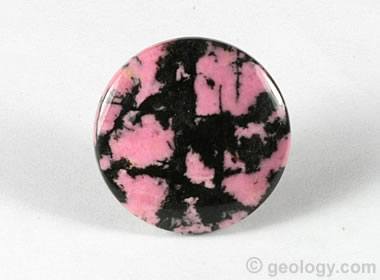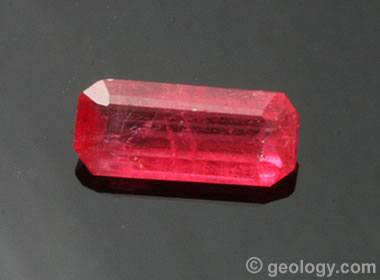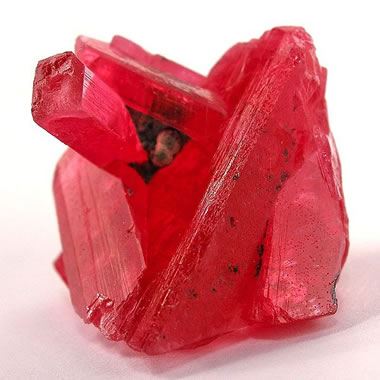Rhodonite
A pink to red manganese silicate used as a gemstone and minor ore of manganese.
Article by: Hobart M. King, PhD

Rhodonite from Nevada: Rhodonite with its characteristic matrix and fracture-filling of manganese oxide. This specimen from Humboldt County, Nevada was photographed by Chris Ralph of Nevada-Outback-Gems.com and is displayed here as a public domain image.
What is Rhodonite?
Rhodonite is a pink manganese silicate mineral of variable composition that often contains significant amounts of iron, magnesium, and calcium. It has a generalized chemical composition of (Mn,Fe,Mg,Ca)SiO3. Rhodonite is often associated with black manganese oxides which may occur as dendrites, fracture-fillings, or matrix within the specimen. Other names for rhodonite include "manganese spar" and "manganolite."
Table of Contents
 What is Rhodonite? What is Rhodonite? Geologic Occurrence Geologic Occurrence Physical Properties Physical Properties Uses of Rhodonite Uses of Rhodonite Compositional and Structural Variations Compositional and Structural Variations |

Rhodonite cabochon: A cabochon cut from pink rhodonite in a matrix of black manganese oxide. The pink color of this specimen is especially nice, and the manganese oxide is typical. This cabochon is about 28 millimeters in diameter.
Geologic Occurrence
Rhodonite is usually found in metamorphic rocks associated with other manganese minerals. It is also found in rocks that have been altered by contact metamorphism, hydrothermal and metasomatic processes. It is usually massive to granular in occurrence. Rarely, it is found as red triclinic crystals.
Rhodonite is an uncommon mineral. It is found in a few small deposits across the world. Sources of rhodonite include: Argentina, Australia, Brazil, Canada, England, India, Peru, Russia, and Sweden. In the United States it has been found in North Carolina, Colorado, New Jersey, and has been named as the state gem of Massachusetts.
Physical Properties of Rhodonite |
|
| Chemical Classification | Silicate |
| Color | Pink, red, reddish brown to brown when weathered |
| Streak | White |
| Luster | Pearly to vitreous |
| Diaphaneity | Transparent to translucent |
| Cleavage | Perfect, two directions, 90 degrees |
| Mohs Hardness | 5.5 to 6.5 |
| Specific Gravity | 3.5 to 3.7 |
| Diagnostic Properties | Pink color, cleavage, specific gravity, frequent association with black manganese oxide |
| Chemical Composition | (Mn2+,Fe2+,Mg,Ca)SiO3 |
| Crystal System | Triclinic |
| Uses | Decorative stone, gemstones |
Physical Properties
Rhodonite's diagnostic properties are its pink to red color, hardness, high specific gravity, perfect cleavage, and its close association with black manganese oxides. It is sometimes confused with rhodochrosite, which is softer and effervescent in hydrochloric acid, or thulite, which is usually not associated with black manganese oxides. The physical properties of rhodonite are summarized in the table on this page.

Faceted rhodonite: Rhodonite is rarely seen as a faceted stone. Excellent crystals of rhodonite are very rare and usually sell for such high prices to mineral collectors that very few are faceted. Occasionally, broken or second-quality crystals are faceted. Because of their cleavage and low hardness, faceted specimens of rhodonite are more in demand as "collector gems" than for use in jewelry.
Uses of Rhodonite
Rhodonite was once used as ore of manganese in India. Today its only uses are as lapidary materials and as mineral specimens. High-quality crystals of rhodonite can sell for very high prices. Good massive pink- to red-colored material is used as an ornamental stone or gem rough. It is typically used to make cabochons, beads, small sculptures, tumbled stones, and other lapidary projects.
Rare, well-formed, transparent crystals are highly sought after by mineral collectors. Damaged crystals of good quality are sometimes cut into faceted stones. Most of these are acquired by collectors because their cleavage and low hardness make them too fragile for use in jewelry.

Rhodonite crystals: A nice cluster of rhodonite crystals from Minas Gerais, Brazil. Specimen is about 2.5 centimeters in height. Specimen and photo by Arkenstone / www.iRocks.com.

The best way to learn about minerals is to study with a collection of small specimens that you can handle, examine, and observe their properties. Inexpensive mineral collections are available in the Geology.com Store. Image copyright iStockphoto / Anna Usova.
Compositional and Structural Variations
Specimens of rhodonite that contain up to 20% calcium oxide are usually grayish brown in color and are known as "bustamite." "Fowlerite" is the name given to specimens that contain up to 7% zinc oxide. Specimens with a brown color have usually been altered by weathering.
Rhodonite is one of two minerals with a chemical composition of manganese silicate. The other is a high-temperature, low-pressure polymorph known as "pyroxmangite."

Tumbled rhodonite: Rhodonite is sometimes used to make tumbled stones in a rock tumbler. Many people enjoy the raspberry color of rhodonite against the black manganese oxide. Rhodonite is a good tumbling rough for experienced tumblers. The material most often offered as a tumbling rough is inexpensive and with significant amounts of black manganese oxide. It can be challenging to polish because the manganese oxide often has a hardness that is different from the rhodonite. This results in overcutting of one material and undercutting of the other.
| More Minerals |
 |
Herkimer Diamonds |
 |
The Acid Test |
 |
Tumbled Stones |
 |
Zircon |
 |
Fool*s Gold |
 |
Kyanite |
 |
Rock Tumblers |
 |
Rhodochrosite |

Find Other Topics on Geology.com:

|

| ||

|

| ||

|

| ||

|

|
